Do you also dream of having your own home-grown coffee from within your own four walls? This is not easy with your own coffee plant, but it is possible.
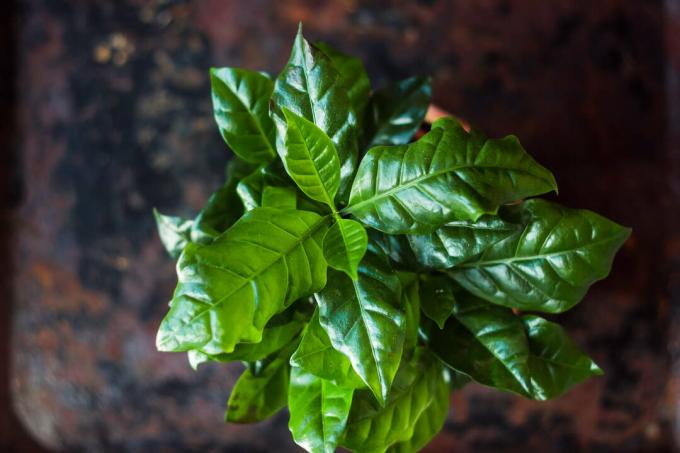
Coffee actually grows in the tropics, but the plant can thrive here too. With the right site conditions and proper care, it is even possible to harvest coffee cherries and obtain the beans. Here we show what a suitable location looks like and what you should consider when planting.
contents
- Coffee plant: flowering, origin and characteristics
- Types and varieties of coffee plants
-
Plant coffee
- The right location for the coffee plant
- What soil does the coffee plant need?
- Coffee plant as a houseplant
- Can you keep the coffee tree outside?
-
Multiplication
- Propagation via seeds
- Propagation via cuttings
- Hibernate the coffee plant
- Is the coffee plant poisonous?
Coffee plant: flowering, origin and characteristics
The coffee plant (Coffea) is not just something for coffee lovers, because it can convince with its flowers and leaves alone. Today it is widespread in almost all tropical and subtropical regions of the world and belongs to the Rubiaceae family. There coffee is grown on plantations, as it is an economically extremely important plant. In nature, the coffee plant grows into trees up to 8 meters high. If you want to keep coffee as a houseplant, you have to be content with a maximum size of 2 meters.
Coffee has quite large, oval, pointed leaves with a glossy surface and a wavy edge. The coffee plant blooms in April and May. These are found in clusters in the leaf axils. They are white and have a pleasant smell of jasmine. However, it takes two to four years for a coffee plant to flower for the first time, depending on whether the plant was grown from a cuttings or seeds. After successful pollination, the fruits are formed at this point, which are recognizable as green, later red coffee cherries. It takes a whole year for the coffee berries to turn red to dark purple, i.e. ripe. Under good climatic conditions, the fruits in the growing regions can be ripe after just nine months.
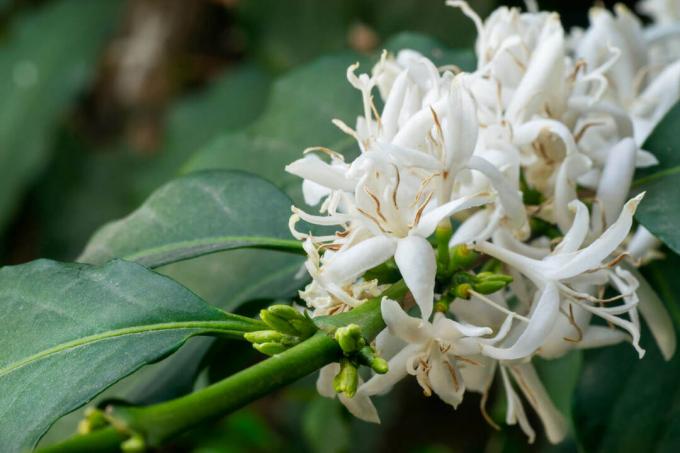
From this point on, the coffee plant can be harvested. There are two seeds in the berries, the coffee beans. They are initially light brown or white and only turn dark brown when they are later roasted. Roasting is a common processing step in order to then grind the coffee seeds and brew them into the well-known drink. Due to the caffeine it contains, coffee wakes us up, often also brightens our mood and has therefore become a popular luxury food. With the right one Care of the coffee plant and if you are lucky, you can also harvest your own coffee plant.
Tip: With permanent and constant exposure, the coffee plant even bears flowers and fruits all year round. In our part of the world, however, this would only be possible with enormous expenditure of energy for intensive lighting.
Types and varieties of coffee plants
Of the around 124 different Coffea- Species are above all the species Coffea arabica and Coffea canephora, also called "Robusta", economically significant. They are also often offered as indoor plants.
- Coffea arabica: This type is known as highland coffee, so it grows in nature in higher regions above 1000 meters above sea level. The species is self-pollinating and therefore ideally suited to try your hand at making your own coffee beans.
- Coffea arabica "Nana": You can often find the dwarf coffee bush in stores, as it remains quite small at around 150 cm and grows compactly.
- Coffea canephora: Rather under the name Coffea robusta the species is known Coffea canephora. It is a lowland coffee that can withstand slightly warmer temperatures and higher humidity. At temperatures above 30 ° C, however, this species should not stand either.
- Coffea liberica: This species can also be kept as a houseplant, but is rarely offered. The leaves are a little lighter than the other two species and they usually have a somewhat wilder and more messy appearance.
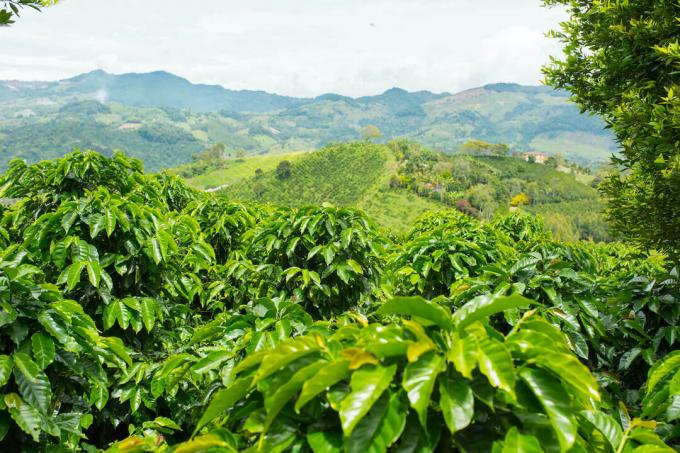
Plant coffee
While enjoying a delicious cup of coffee, you've probably asked yourself: Can you actually grow coffee plants yourself? That's fine. And the posture isn't even particularly difficult. You can grow a coffee plant from seeds or cuttings, or purchase a ready-made small plant from stores.
The right location for the coffee plant
Coffee actually grows in the high altitudes of the tropics and needs appropriate conditions here too. For this reason, the coffee plant is kept in a pot and may only be put outside in summer, where it prefers a shady place. In winter, the coffee plant needs a location in the apartment that is light, warm and humid. It does not tolerate direct sun very well; an east or west window with a few hours of sunshine in the morning or in the evening is better. The temperature should be around 20 to 25 ° C all year round and if possible not fluctuate. Even in winter, the temperature must not drop below 15 ° C. High humidity is also important for a healthy coffee plant. You can achieve this, for example, by regularly spraying the leaves or by using a shallow bowl with water and expanded clay on which you place the pot of the coffee plant.
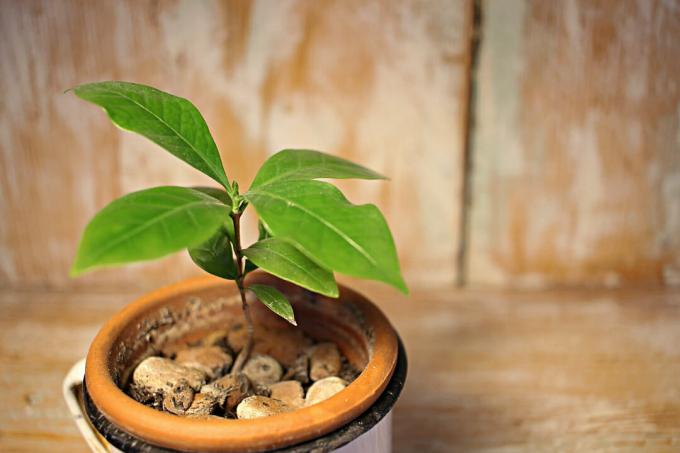
It is also possible, Coffee plants in the glass to keep, whereby this can either be bought ready-made or created yourself. You need for such one Bottle garden a tightly fitting jar, for example a mason jar, in which a layer of expanded clay is placed for drainage. This is followed by a layer of substrate and then the coffee plant. The rest of the earth is covered with living moss. Now everything is moistened well, but not soaked. Seal the jar and place it in a bright place out of direct sunlight.
For one Kokedama coffee plant, i.e. a coffee tree in a moss ball, one part peat is mixed with one part clay and everything is moistened well so that the mixture can be shaped, but is not mushy. Then take a small coffee plant out of its old substrate and soak the root ball in water. The root ball is now coated with the peat-clay mixture and everything is carefully pressed into place. Now you need a large, dry sheet of moss that you drape around the globe and wrap it with a piece of string until everything is firm. Such a Kokedama is a real eye-catcher and can be hung with the help of the thread. For irrigation, the moss ball is simply sprayed with water from the outside.
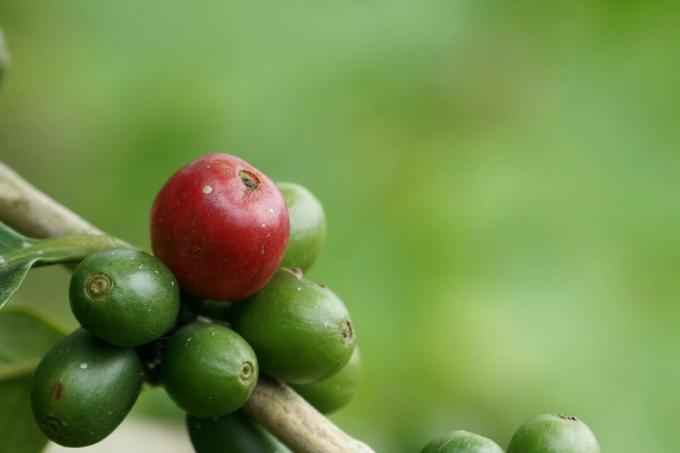
The Coffee plant in hydroponics represent. The plant stands in expanded clay and is supplied with nutrient solution via a planter. the Hydroponics is very simple and ensures good humidity on the plant, but it is also more likely to be classified as environmentally harmful. Because in hydroponics, mineral fertilizers are usually used, sustainable, primarily organic fertilizers such as ours Plantura organic fertilizer cannot be used. We therefore generally do not recommend hydroponics.
Tip: All alternative methods also help to automatically increase the humidity in the vicinity of the coffee plant.
What soil does the coffee plant need?
If you want to keep the coffee plant in soil, you first and foremost need a well-drained substrate. The soil should be slightly acidic, rich in nutrients, with little peat and a lot of humus. Our peat-free one, for example, meets these requirements Plantura organic potting soilthat has a high proportion of organic matter and can store water well without becoming wet. For even better drainage, mix the soil with 30% expanded clay or sand.
Tip: For constant soil moisture, the soil should be covered with a layer of mulch. This means that less water can evaporate from the soil. For example, slightly acidic pine bark like ours is suitable Plantura organic pine barkthat comes from low-pollutant cultivation and is therefore more environmentally friendly than conventional bark mulch.
Coffee plant as a houseplant
If the coffee plant is kept as a houseplant, the main thing to look out for is the water drainage, but at the same time a regular water supply. Coffee cannot tolerate waterlogging at all and can lead to root rot. Choose a deep pot so that there is enough space for the roots. A drainage layer made of stones or expanded clay on the bottom of the pot prevents the coffee plant from standing in the water. The substrate mixture in which the coffee is planted is then placed on the drainage layer. In order to meet the enormous water requirements of the coffee plant, it is best to water daily so that the substrate is always moist, but never saturated with water.
In order to be able to harvest fruit from the houseplant, you also have to help a little with the pollination of the flowers. Coffea arabica While it is self-pollinating, a little help won't hurt. To do this, simply grab a fine brush and carefully rotate it in each flower.
Last but not least, a sufficiently high level of humidity must of course be ensured, which is usually achieved automatically in bright bathrooms. Living rooms, on the other hand, are often too dry for the coffee plant.
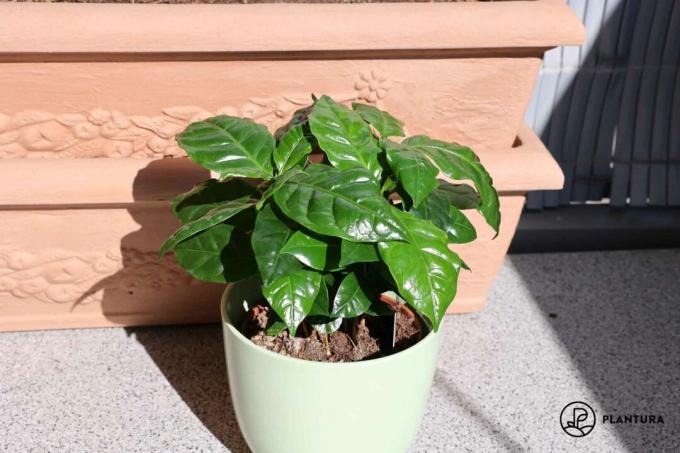
Can you keep the coffee tree outside?
In summer the coffee tree can be put outside. It needs a protected place in partial shade, preferably under a larger plant, and should also be sprayed with water here from time to time. If it gets colder than 15 ° C at night, it is better to bring the coffee plants back into the house.
Multiplication
There are two ways to propagate your coffee plant. If you already have a plant, cuttings are ideal. Propagation via seeds can take place from their own seeds or from purchased seeds. The seeds must be fresh, however, as their ability to germinate decreases quickly and disappears completely after about two months. Of course, roasted coffee beans can no longer germinate either.
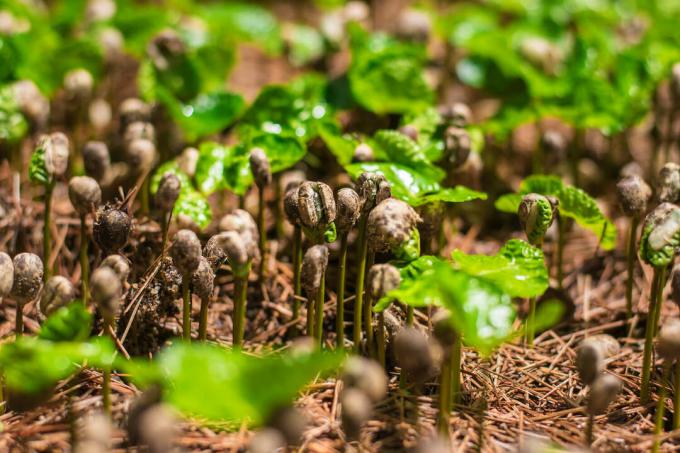
Propagation via seeds
In order for the coffee beans to become a plant, the seeds must first be soaked in water for about 24 hours. This should have a temperature of around 25 to 30 ° C. For example, a thermos can be used for this. For sowing, a planter is filled with potting soil, for example with ours Plantura organic herb & seed compost. Our organic soil consists of natural ingredients and does not require any peat. The low nutrient content is specially tailored to the seedlings, which cannot use large amounts of nutrients at all and develop stronger roots when there is less supply.
The coffee seeds are put about 1 cm deep into the soil and the substrate is slightly moistened. Put a plastic bag over it and place the container at a temperature of at least 23 ° C. It takes about four weeks for germination. During this time, the soil should always be kept slightly moist and the plastic bag should be ventilated daily so that no mold develops. Then the pot is placed in a light spot so that the seedlings can continue to grow and finally be repotted.
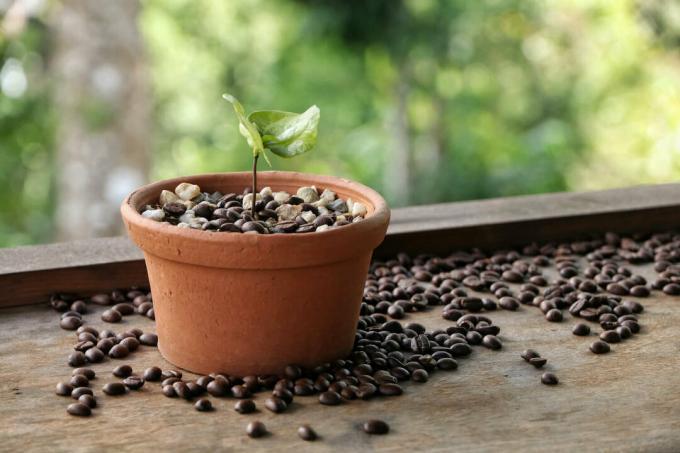
Propagation via cuttings
Coffee plant cuttings are cut in spring when the growth phase begins. The cutting should be cut from the tip of the central shoot so that it continues to grow straight up. It is important that the shoot section is not yet lignified, has no buds or fruit and already has two to three leaves. All remaining leaves are removed from the 8 to 20 cm long shoot.
Put each cutting individually in a pot with potting soil and keep the soil constantly moist. A bright and warm place with temperatures of 24 to 28 ° C should be chosen. A plastic bag placed over it increases the humidity and thus the chances of success of the propagation - but it should be ventilated regularly. Roots should have formed after two to three months.
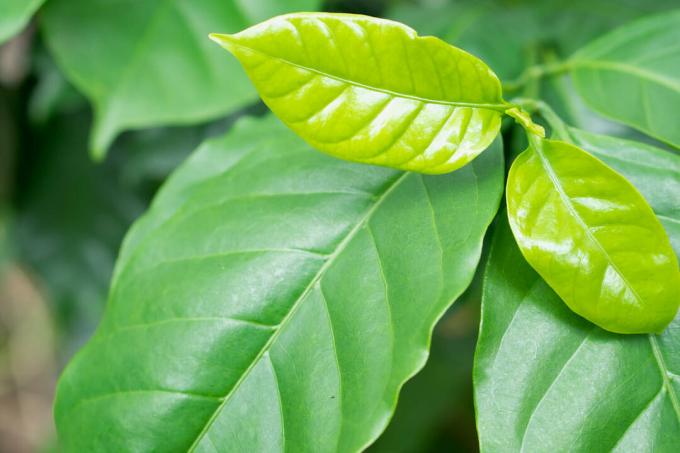
Hibernate the coffee plant
Since coffee plants are not hardy, they must not be left outside in winter. A bright and warm place at around 20 ° C is best suited to overwinter the coffee plant. Since the air is dry in winter, you should also ensure that there is sufficient humidity. The best way to do this is to place water bowls on the heater near the coffee plant. Alternatively, it can be sprayed with water regularly. In winter there is a little less watering and no fertilization, as the coffee plant hardly grows at this time.
Is the coffee plant poisonous?
The coffee plant is not poisonous for humans, but with a little luck it can even be used to make your own coffee. However, it looks different with pets. To be on the safe side, cat owners should place the coffee plant in a place inaccessible to the cat. Because if the coffee cherries are consumed in large quantities, the caffeine they contain can lead to vomiting or diarrhea in pets. The leaves, on the other hand, contain only very small amounts of the active ingredient and are harmless.
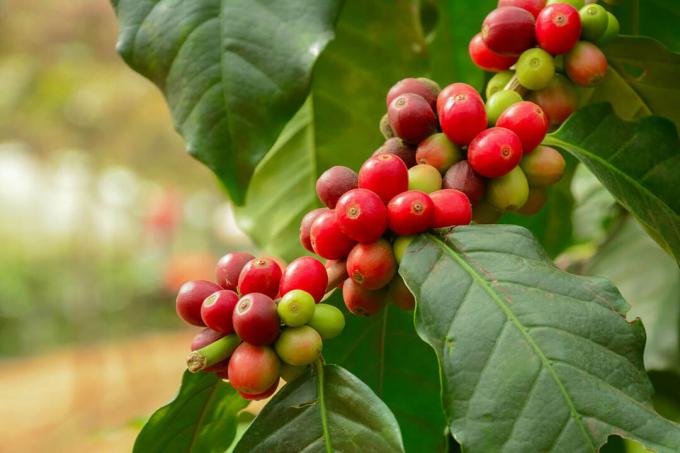
Tip: In nature, caffeine is beneficial to the coffee plant. It inhibits the germination of other plants in the area and prevents food debris from eating the leaves and fruits.
Now it just depends on the right one Care of the coffee plant at. We will show you how to water, fertilize and cut the coffee plant appropriately, and give helpful tips.
